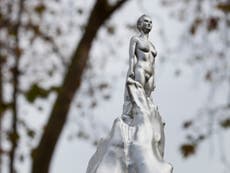The statue for Mary Wollstonecraft is fearless and brave – she doesn’t need clothes to tell us that
If the statue was to wear 18th-century garb, would that have been right? To imprison her in the past, trap her in corsets and ruffles?


What are clothes? They provide warmth, and shield us from the elements. They protect our “modesty”. What business, then, does a statue have wearing clothes?
The new and extremely controversial statue in Mary Wollstonecraft’s honour, unveiled this week in London, is as naked as the day she was born – or sculpted. And I love her for it. Critics – including my colleague Harriet Hall – have argued that her nudity sexualises this representation of a woman, that artist Maggi Hambling has fallen into the “male gaze” in her creation.
Nudity, I don’t think, is inherently sexual, though – and nor should it be seen to be. When women are thrown out of cafes for breast-feeding, or told to cover up, we rightly baulk at this. Our bodies are lots of things, and they can be sexual, but they can also be strong and powerful, and can help defend us against the world. They bring us pain and they bring us joy and they are the only thing we all have.
As Hambling has said, the sculpture is not designed to represent Wollstonecraft, but rather “every woman”. Quite why the Wollstonecraft statue campaign – who had been lobbying for a statue for the 18th-century writer for years – decided to go for something representing all women, and not the philosopher herself is a different matter. But once they did, I can think of no greater tribute.
Perhaps a statue of her would have been more “appropriate”, and it’s true there aren’t many statues of naked men around London. The ancient Romans and Greeks had no problem, though, sculpting the naked male form. Male figures became symbols to worship, god-like (if not actual gods) in their towering chiselled beauty.
And what clothes would this statue wear, were it to wear clothes? Timeless, universal fashion is hard to find – as is fashion’s way. Were she dressed in anything specific, she would date. Or fail to feel accessible to every woman walking past. If the statue was to wear 18th-century garb, would that have been right? To imprison her in the past, trap her in corsets and ruffles? Informed by their contemporary setting, clothes are not without politics. Why consign this every woman statue to a political period? “It’s crucial that she is ‘now’,” Hambling said, following the controversy.
Women do not need adornments to make them beautiful – they do not need accessories or additions. Every woman is perfect as she is, in her own body. I can think of no better way of putting that message into sculpture than having her naked, and I think Hambling has done so elegantly and sensitively.
So many statues of men are of victors. Their clothes and military uniforms, or the horses they sit upon, are symbols of their battles and their bravado. Wollstonecraft’s every woman’s stance and her growl speak to me of a warrior-athlete, a woman who is fearless and brave. But she doesn’t need her clothes to tell us that. I want to be friends with her and I want to be like her.
She is now and she is always, a demi-goddess, an ancient sculpture and every woman. Emerging from a swirling mass of sisterhood, she exists in a male-free universe, a world of women holding her up. She lives without shame, and she does not want to hide.



Join our commenting forum
Join thought-provoking conversations, follow other Independent readers and see their replies